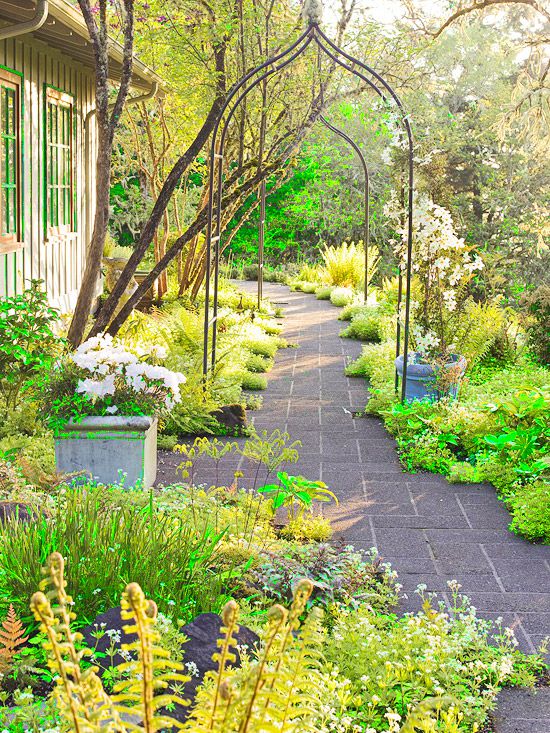A well-designed garden path does far more than help you move from one spot to another—it defines your garden’s personality, guides the eye, and creates flow and harmony throughout your outdoor space. Whether you’re aiming for a whimsical cottage look, a clean modern feel, or a rustic natural setting, the right garden path can elevate your entire landscape.This is your ultimate guide to garden path ideas, materials, styles, and practical tips to design a walkway that enhances both beauty and function.🌼 Why Garden Paths MatterA garden path:Adds structure and organizationProtects your plants from foot trafficMakes gardens accessible and walkableEnhances aesthetic appealCreates focal points and visual directionMakes small gardens feel bigger and big gardens feel cohesiveThink of it as the backbone or roadmap of your outdoor space.🌱 Popular Garden Path MaterialsChoosing the right material is one of the most important steps. Here are the top options with pros, cons, and design inspiration.1. Gravel PathsGravel is budget-friendly, natural-looking, and easy to install.Pros:✔ Great drainage✔ Rustic and casual charm✔ Inexpensive✔ Easy DIY optionCons:✘ Weeds can appear✘ Needs edging to stay in placeBest for: Cottage-style gardens, relaxed walkways, long curves2. Stone or Flagstone PathsStone paths bring elegance, durability, and a timeless look.Pros:✔ Extremely durable✔ Natural texture✔ Works with almost any landscape styleCons:✘ More expensive✘ Heavy and requires careful placementBest for: Classic gardens, modern spaces, woodland settings3. Brick PathsBrick adds warmth and old-world charm.Pros:✔ Strong and stable✔ Loved in English-style gardens✔ Great for formal layoutsCons:✘ Can shift if not installed properly✘ Moss may grow in shady areasBest for: Cottage gardens, vintage looks, symmetrical designs4. Wood Paths (Planks, Decking, or Timber)Perfect for natural, forested, or coastal areas.Pros:✔ Soft underfoot✔ Warm and organic✔ Ideal for slopes or damp areasCons:✘ Requires sealing to avoid rot✘ Not suitable for extremely wet climatesBest for: Woodland gardens, modern minimalism, Japanese gardens5. Mulch PathsA highly organic and easy option.Pros:✔ Cheapest material✔ Soft, natural feel✔ Easy to replace or adjustCons:✘ Needs frequent refreshing✘ May not be ideal for high-traffic areasBest for: Nature trails, vegetable gardens, relaxed layouts6. Paver PathsConcrete pavers come in many styles and colors.Pros:✔ Uniform look✔ Great for formal designs✔ Easy to clean and maintainCons:✘ Can look too structured for informal gardensBest for: Modern gardens, sleek walkways, geometric designs🌿 Garden Path Design StylesChoosing the right style will define your garden’s character.1. Curved PathsSoft, flowing curves create a sense of mystery and exploration.Perfect for:Cottage gardensLarge yardsFlower-heavy landscapes2. Straight PathsClean, bold, and purposeful.Perfect for:Modern gardensFormal layoutsEntryways3. Stepping-Stone PathsGreat for guiding movement without dominating the landscape.Perfect for:Japanese gardensWoodland areasLow-maintenance designs4. Mixed-Material PathsCombine gravel with stone, brick with mulch, or wood with stepping stones to add texture and interest.Perfect for:Creative gardenersUnique, custom designs🌼 Add Beauty with AccentsTransform your path from simple to stunning with these additions:✔ Border plantsUse lavender, hostas, creeping thyme, boxwood, marigolds, or ornamental grasses.✔ LightingSolar lights, lanterns, or recessed walkway lights create nighttime magic.✔ Arches or arborsFrame your path with roses or clematis for a storybook entrance.✔ Garden edgingBrick, stone, metal, or plastic edging keeps materials neat and clean.✔ Water featuresA path alongside a small fountain or pond adds tranquility.🌿 Practical Tips for Creating the Perfect Garden Path1. Plan first, dig laterSketch your garden layout to ensure your path flows with your landscape.2. Think about foot trafficHigh-traffic areas need durable materials like stone or pavers.3. Consider drainageAvoid low spots where water collects—elevate or slope slightly for runoff.4. Use proper edgingThis prevents gravel, mulch, or soil from spilling into the path.5. Choose the right width36–48 inches for frequent use18–24 inches for decorative or light use6. Blend form with functionUse curves for beauty, straight lines for efficiency, and materials that match your home.🌸 Garden Path Ideas for Different Garden StylesCottage Garden PathCurved layoutGravel or stepping stonesOverflowing borders of flowersSoft lightingModern Minimalist PathStraight linesPavers or large stone slabsClean bordersMonochromatic plantsWoodland Garden PathMulch or natural stoneFerns, hostas, and shade-loving plantsMoss accentsSoft lightingFlower Garden PathBright, layered plantingsStepping stones or bricksBees and butterflies everywhereVegetable Garden PathMulch or gravelWide enough for toolsClear division of planting beds🌺 Conclusion: Your Ultimate Guide to Garden Path Success!A garden path is more than a walkway—it’s a design statement, a functional necessity, and a chance to express your style. With the right materials, layout, and accents, you can transform any outdoor area into a beautiful, organized, and inspiring space. From romantic cottage paths to sleek modern walkways, the possibilities are endless.With this ultimate guide to garden path, you now have all the inspiration and knowledge to create a path that elevates your entire garden.

